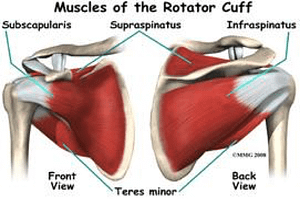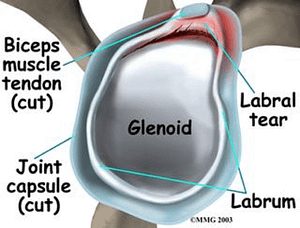The shoulder is a ball and socket joint made up of the head of the humerus (arm bone) and the glenoid cavity of the scapula (shoulder blade). Because the shoulder joint is the most mobile joint in the body, it’s also the joint that is the most unstable. The following are the three most common causes of shoulder instability:
Rotator Cuff Injuries
The rotator cuff muscles and tendons hold the shoulder in place and help move it. Age and/or injury can partially or completely tear the rotator cuff tendons and cause shoulder instability. When the rotator cuff tendons are torn, the head of the humerus loosely fits in the glenoid cavity. Movement can cause a partial dislocation (subluxation) or complete dislocation. In many cases, physical therapy can be used to strengthen an injured rotator cuff and improve shoulder instability. A rotator cuff that is completely torn may require surgical intervention in the form of a rotator cuff repair.

Illustration 1- The muscles and tendons of the rotator cuff
Shoulder Labrum Injuries
An outer rim of cartilage known as the labrum surrounds the glenoid cavity. A healthy labrum allows the head of the humerus to sit perfectly in the glenoid cavity. A partially or completely torn labrum allows the head of the humerus to move in and out of the cavity. Like rotator cuff tears, labral tears are caused by age and/or injury. The degree of shoulder instability corresponds to the severity of the tear. Small tears may be treated non-surgically. Large, complete tears may require surgical intervention. The most common labral injuries that require surgical intervention are a superior labral anterior to posterior (SLAP) tears and a Bankart tears.

Illustration 2- A partially torn labrum
Repetitive Strain
Many patients are born with loose shoulder ligaments. When overhead sports and/or activities are performed, the ligaments are stretched and shoulder instability may develop. The best way to treat shoulder instability caused by loose ligaments and repetitive strain is by using physical therapy to strengthen the shoulder muscles, tendons, and ligaments.
Seeking Treatment for Shoulder Instability
If shoulder instability is affecting the way you live your life, please don’t hesitate to contact our office to arrange an appointment with one of our orthopedic shoulder specialists. Regardless of the cause of your shoulder instability, we’ll have a treatment option that’s right for you. You can expect results when you choose our clinic.
High Mountain Orthopedics specializes in bone, joint and muscle injuries, including shoulder injuries. Dr. William Matarese, Dr. Tony Wanich and Dr. Sherwin Su have over 25 years of combined experienced treating orthopedic and sports injuries. Our practice uses a multi-disciplinary approach that includes physical therapy and activity modification. If surgery is necessary, our team utilizes the latest advancements in Minimally Invasive and Arthroscopic procedures to expedite the healing process. If you are suffering from a bone, joint or muscle injury – contact our offices today! We have locations in Wayne, Paramus and Englewood, NJ

